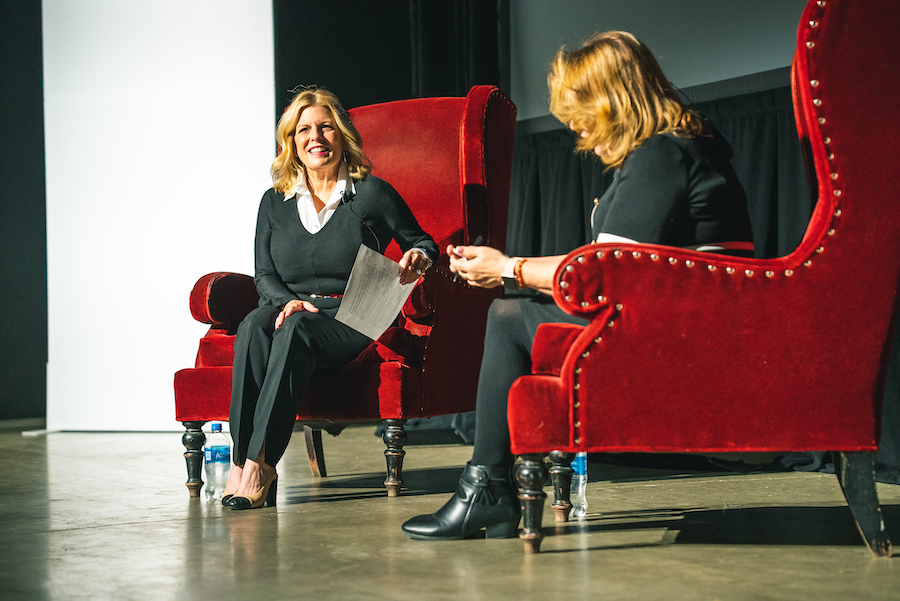The Workplace of the Future: A Magnet for Collaboration


In the hybrid work era, the future of office culture is an important consideration for business leaders. CBRE, the world’s largest commercial real estate and investment firm, has 600 offices in 100 countries. Elizabeth Jenswold, senior vice president and global head of people for CBRE, has an inside look at how workplace design can foster a purposeful culture. “An office should be a magnet and a destination,” she said recently. “Not an obligation.”
In a fireside chat at From Day One’s Dallas conference, Jenswold told moderator Christine Perez, editor of D CEO Magazine, “Likely everyone in this room is starting to reimagine what the new office will potentially be.”
As some business leaders focus on how to bring employees back into the office, each business is taking a different approach. Culturally, Jenswold said, “We have to acknowledge that we’ll all have a different approach, and we have to ensure that people are having an experience when they’re coming back to the office.”
At CBRE, offices are used to express their brand. Jenswold said, “That means that we are bringing people together in a meaningful way, and we impress our culture on them by having an environment where people like to come.”
“The office environment should be used to empower people,” she continued. The pandemic brought incredible changes to how we work, and Jenswold suggested that, as we move into this new way of working, companies should focus on environments that help employees be their “most productive selves.”
To accomplish this, CBRE trains their managers to openly communicate with employees about what it means to be productive at work.
She said, “What we’ve designed in our practice more than our policy is to have managers to have open conversations about what productivity means for their team.” This approach requires strong leaders who can have open and honest conversations with employees, can see each employee as an individual, and are willing to be flexible.

Jenswold continued, “That’s a big change in the way we work, for both employees and managers. Not just at CBRE, but across all of our companies globally. What does it mean to be heard?”
When it comes to returning to work, whether a company chooses to ask all of their employees back to the office, or a company chooses to remain all remote, employees are feeling the pros and cons of each choice. Jenswold said, “The businesses who have gone to one extreme or the other are having more challenges. The hybrid work environment seems to be the sweet spot.”
With this, Jenswold said that companies should carefully consider creating a “harmonious, collaborative environment.” One strategy: offering a more casual office dress code. Additionally, the technology at home should transition back to the office with ease. Ultimately, she said, “We want the transition from home and in-office work to be seamless.”
She added that “reimagining the role of your managers” will help with the back-to-work transition. She said, “HR professionals are spending a lot of time on that. What is the role of that manager, and how is that manager helping with this seamless transition, when half of the staff is at home and half of the staff is in the office?”
She said, “It’s critical that managers get good at that. How do we replace an inclusive environment for people who aren’t in the same room every day? Managers need to be focused on being equitable versus fair by recognizing people as they are, as individuals with imperfect lives.”
Business leaders need to consider creating an in-office experience, which Jenswold says should include all of the technology they need, a quiet space, and a social space. Ultimately, she said, “workers want companies to care about them.” She continued that this includes a healthy environment with clean air, healthy snacks, pleasing lights, and sunshine.
The evolution of the workspace speaks directly to the purpose of the office. The purpose of the office goes back to branding and is an opportunity to reflect the values of the company. Jenswold said, “When you think about a reflection of your brand, you have to be careful that you’re authentic. If you’re saying our brand is bold and smart, for example, but have leadership that isn’t taking risks or making good decisions, it doesn’t really matter what your offices look like if you can’t model that for your employees.”
Finally, she said, “The workplace has evolved to be incredibly inclusive. Think about all of the people that work for you. Consider neurodivergent employees regarding lighting and noise control, for example. How do we make offices a peaceful place to be, and how can we operate with more humanity?”
Christina Cook is a freelance writer based in Dallas, TX, where she covers a variety of topics, with favorites including art, film, and live theatre. Her work can be seen on Rawckus.com, RedDirtNation, and DallasArtBeat.com. Christina is also a creative writer. Her children’s book Your Hands Can Change the World was a 2017 regional bestseller.
The From Day One Newsletter is a monthly roundup of articles, features, and editorials on innovative ways for companies to forge stronger relationships with their employees, customers, and communities.